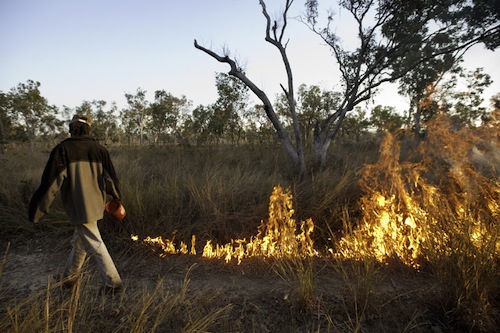Michael Looker is the director of The Nature Conservancy’s Australia division.
By going back in time, Fish River Station is making history — again.
For millennia, this piece of northern Australia was managed by Indigenous Australians. The many small fires they set as they moved about and managed their homelands nurtured and supported the biodiversity that, in turn, supported them. Fire is one of the principal ecological processes that shapes northern Australia’s savannas; it’s the region’s most powerful conservation tool.
When Indigenous land tenure was disrupted by European settlement and Fish River Station became a cattle ranch, the region’s traditional fire regime was replaced by damaging and uncontrolled late dry season wildfires.
“Historically, 69 percent of the property would be burnt by late dry season wildfires,” Joe Morrison, CEO of the Northern Australia Indigenous Land and Sea Management Alliance (NAILSMA), says of Fish River.
But, since The Nature Conservancy and partners helped the Indigenous Land Corporation (ILC) purchase Fish River Station in 2010, NAILSMA has been working with the Conservancy and the ILC to reinstate controlled early dry season burns (as well as control feral animals and track threatened species) in the area. By starting prescribed burns in the early dry season, the Indigenous Rangers that maintain the property are putting in fire breaks and dividing up the country, which protects the savanna from destructive uncontrolled burns in the late dry season.
The reinstatement of these traditional burn patterns and practices is having a huge impact on the health of the land and local people. Joe says that combining Indigenous knowledge of the local landscape with the latest in prescribed burn technology has limited the late-season wildfire destruction on Fish River to less than 3 percent of the property.
These smaller, cooler fires are also good for the entire globe. By cutting down on the incidence of bigger wildfires, controlled burns can actually reduce the amount of greenhouse gases emitted into our atmosphere.
And that’s where the latest bit of history comes in: Fish River Station is now Australia’s first savanna burning project to be approved under the Australian Government’s Carbon Farming Initiative (CFI).
Under Australia’s carbon pricing scheme, which went into effect earlier this year, the CFI provides Australian land managers with credits for activities that store carbon or otherwise reduce the emissions of greenhouse gases. This was only the sixth project to gain approval under the CFI; it was the very first land sector project to be approved.
The fire activities that Indigenous Rangers conduct on Fish River Station will create 20,000 Australian Carbon Credit Units each year. Those credits can then be sold on the carbon market. The sale of these credits will then go toward helping to sustainably finance conservation and land management work on the station.
Fish River Station is an important first—it paves the way for a model that could be applied across Northern Australia. The Conservancy, in partnership with NAILSMA and the ILC, will continue to build on the success of Fish River with the planned expansion of the model across northern Australia.
Dr. Dawn Casey, chair of the ILC, says that the progress at Fish River Station is an important beginning for Indigenous Australians in the north as they look to maintain their cultural connection with their traditional lands and protect them, too.
Huge expanses of this region once benefited from the stewardship of Indigenous people. Today, with the government’s endorsement and the ability to raise more money for conservation through fighting climate change, we’re hopeful that we can make even more history and restore one of northern Australia’s great environmental traditions.
To learn more about the Conservancy’s work in Australia, visit www.natureaustralia.org.au.
[Image: An early dry-season prescribed burn at Fish River Station in Australia's Northern Territory. Image source: Ted Wood]
